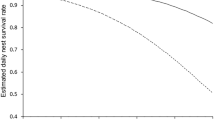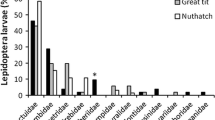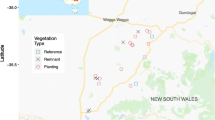Abstract
Fragmentation and other habitat disturbances are long known to negatively affect birds, in large part by decreasing nest success due to high nest predation rates. The factors, however, that cause this decrease in nest success are still poorly understood and may vary among regions or species. Here, we show that nest survival is also lower in a disturbed landscape versus a protected cerrado (savanna-like) Neotropical landscape. Also, we tested the importance of garbage in the nest, brood parasitism, microhabitat and bird family in nest survival, controlling for temporal effects. We monitored 144 birds’ nests in a disturbed landscape and 150 nests in a natural reserve of cerrado vegetation in central Brazil, between September and December 2006. We used Program MARK to estimate nest survival probabilities and evaluate the effect of covariates in nest success in the disturbed area. Nest daily survival rate (DSR) was higher in the reserve (survival probability = 29.4%) than in the disturbed landscape (survival probability = 16.6%). Nest daily survival rate (DSR) was smaller in nests with garbage (survival probability = 9.3%) than in nests without garbage (survival probability = 19.5%) in the disturbed landscape. Effects of habitat disturbance on nest survival differed among bird families, with finches and tanagers being more affected mostly due to high nest predation rates. Conservation and management of birds in disturbed landscapes should include actions to decrease nest predation. In poor rural or suburban areas in developing countries, such as Brazil, actions like better garbage treatment may help conserve birds in disturbed landscapes.

Similar content being viewed by others
References
Aleixo A, Vielliard JME (1995) Composição e dinâmica da avifauna da mata de Santa Genebra, Campinas, São Paulo, Brasil. Rev Bras Zool 12:493–511
Andrade RD, Marini MÂ (2002) Bird species richness in natural forest patches in southeast Brazil. Lundiana 3:141–150
Andrén H (1995) Effects of landscape composition on predation rates at habitat edges. In: Hansson L, Fahrig L, Merriam G (eds) Mosaic landscapes and ecological processes. Chapman and Hall, London, pp 225–255
Bayne EM, Hobson KA (1997) Comparing the effects of landscape fragmentation by forestry and agriculture on predation of artificial nests. Conserv Biol 11:1418–1429
Bêty J, Gauthier G, Korpimaki E, Giroux J (2002) Shared predators and indirect trophic interactions: lemming cycles and artctic-nesting geese. J Anim Ecol 71:88–98
Bright PW (2000) Lessons from lean beasts: conservation biology of the mustelids. Mammal Rev 30:217–226
Burnham KP, Anderson DR (1998) Model selection and inference: a practical information-theoretic approach. Springer-Verlag, New York
Cavalcanti RB (1999) Bird species richness and conservation in the Cerrado region of Central Brazil. Study Avian Biol 19:244–249
Cavalcanti RB, Pimentel TM (1988) Shiny cowbird parasitism in central Brazil. Condor 90:40–43
Chalfoun AD, Tatnaswamy MJ, Thompson FR (2002) Songbird nest predators in forest-pasture edge and forest interior in a fragmented landscape. Ecol Appl 12:858–867
Cooch E, White GC (2007) Program MARK: a gentle introduction. http://www.phidot.org/software/mark/docs/book. Accessed 22 Aug 2007
Courchamp F, Langlais M, Sujihara G (1999) Cats protecting birds: modeling the mesopredator release effect. J Anim Ecol 68:282–292
de la Peña MR (2006) Reproducción de las aves argentinas (con descripción de pichones). L.O.L.A, Buenos Aires
Dinsmore SJ, White GC, Knopf FL (2002) Advanced techniques for modeling avian nest survival. Ecology 83:3476–3488
Donovan TM, Thompson FR III, Faaborg J, Probst JR (1995) Reproductive success of migratory birds in habitat sources and sinks. Conserv Biol 9:1380–1395
Duca CG (2007) Biologia e conservação de Neotrhaupis fasciata (Aves: Emberizidae) no Cerrado do Brasil Central. Ph.D. thesis. Universidade de Brasília, Brasília
Duca CG, Gonçalves J, Marini MÂ (2001) Predação de ninhos artificiais em fragmentos de matas de Minas Gerais, Brasil. Ararajuba, Rev Bras Ornitol 9:113–117
Duffy DC (1979) Human disturbance and breeding birds. Auk 96:815–816
Eiten G (1993) Vegetação do Cerrado. In: Pinto MN (ed) Cerrado: caracterização, ocupação e perspectivas. Editora Universidade de Brasília, Brasília, pp 17–73
Evans KL (2004) The potential for interactions between predation and habitat change to cause population declines of farmland birds. Ibis 146:1–13
Fauth PT (2000) Reproductive success of wood thrushes in forest fragments in northern Indiana. Auk 117:194–204
França LC, Marini MÂ (2009) Teste do efeito de borda na predação de ninhos naturais e artificiais no cerrado. Zoologia 26:241–250
Friesen LE, Eagles PFJ, Mackay RJ (1995) Effects of residential development on forest dwelling neotropical migrant songbirds. Conserv Biol 9:1408–1414
Fuller RJ, Gough SJ (1999) Changes in sheep numbers in Britain: implications for bird populations. Biol Conserv 91:73–89
Gates JE, Gysel LW (1978) Avian nest dispersion and fledging success in fieldforest ecotones. Ecology 59:871–883
Grant TA, Shaffer TL, Madden EM, Pietz PJ (2005) Time-specific variation in passerine nest survival: new insights into old questions. Auk 122:661–672
Hartwig E, Clements T, Heckroth M (2007) Plastic debris as nesting material in a kittiwake-(Rissa tridactyla)-colony at the Jammerbugt, northwest Denmark. Mar Pollut Bull 54:595–597
Hazler KR, Amacher AJ, Lancia RA, Gerwin JA (2006) Factors influencing Acadian flycatcher nesting success in an intensively managed forest landscape. J Wildl Manag 70:532–538
Herkert JR, Reinking DL, Wiedenfeld DA, Winter M, Zimmerman JL, Jensen WE, Finck EJ, Koford RR, Wolfe DH, Sherrod SK, Jenkins MA, Faaborg J, Robinson SK (2003) Effects of prairie fragmentation on the nest success of breeding birds in the Midcontinental United States. Conserv Biol 17:587–594
Hobson KA, Bayne E (2000) Effects of forest fragmentation by agriculture on avian communities in the southern boreal mixedwoods of western Canada. Wilson Bull 112:373–387
Hoover JP, Brittingham MC, Goodrich LJ (1995) Effects of forest patch size on nesting success of wood thrushes. Auk 112:146–155
IBAMA—Instituto Brasileiro do Meio Ambiente (2003) Lista das espécies da fauna ameaçada de extinção. Instrução Normativa n° 3, de 27 de maio de 2003. IBAMA e MMA, Brasília
IUCN (2007) 2007 IUCN Red list of threatened species. http://www.iucnredlist.org. Accessed 4 Jan 2008
Jehle G, Adams AAY, Savidge JA, Skagen SK (2004) Nest survival estimation: a review of alternatives to the Mayfield estimator. Condor 106:472–484
Jones J, Ramoni-Perazzi P, Carruthers EH, Robertson RJ (2002) Species composition of bird communities in shade coffee plantations in the Venezuelan Andes. Ornitol Neotrop 13:397–412
Kattan GH, Alvarez-López H, Giraldo M (1994) Forest fragmentation and bird extinctions: San Antonio eighty years later. Conserv Biol 8:138–146
Keyser AJ (2002) Nest predation in fragmented forests: landscape matrix by distance from edge interactions. Wilson Bull 114:186–191
Leite LO, Marini MÂ (1999) The effects of forest fragmentation on predation rates of artificial bird nests in Minas Gerais. Ciênc Cult 51:34–37
Lopes LE, Marini MÂ (2005) Low reproductive success of campo suiriri (Suiriri affinis) and chapada flycatcher (S. islerorum) in the central Brazilian cerrado. Bird Conserv Int 15:337–346
Lopes LE, Góes R, Souza S, Ferreira RM (2004) Observations on a nest of the Stygian Owl (Asio stygius) in the Central Brazilian Cerrado. Ornitol Neotrop 15:423–427
Machado RB, Neto MBR, Pereira PGP, Caldas EF, Gonçalves DA, Santos NS, Tabor K, Steininger M (2004) Estimativas de perda de área do Cerrado brasileiro. Unpublished internal report, Conservação Internacional do Brasil, Brasília
Maldonado-Coelho M, Marini MÂ (2004) Mixed-species bird flocks from Brazilian Atlantic forest: the effects of forest fragmentation and seasonality on their size, richness and stability. Biol Conserv 116:19–26
Marinho-Filho J, Rodrigues F, Guimarães M (1998) Vertebrados da Estação Ecológica de Águas Emendadas—História Natural e Ecologia em um Fragmento de Cerrado do Brasil Central. SEMATEC, IEMA, IBAMA, Brasília
Marini MÂ (2001) Effects of forest fragmentation on birds of the cerrado region, Brazil. Bird Conserv Int 11:13–25
Marini MÂ, Durães R (2001) Annual patterns of molt and reproduction activity of passerines in South Brazil. Condor 103:767–775
Marini MÂ, Garcia FI (2005) Bird conservation in Brazil. Conserv Biol 19:665–671
Marini MÂ, Robinson SK, Heske EJ (1995) Edge effects on nest predation in the Shawnee National Forest, southern Illinois. Biol Conserv 74:203–213
Martin TE (1996) Life history evolution in tropical and south temperate birds: what do we really know? J Avian Biol 27:263–272
Mayfield HF (1961) Nesting success calculated from exposure. Wilson Bull 73:255–261
Mayfield HF (1975) Suggestions for calculating nest success. Wilson Bull 87:456–466
Medeiros RCS, Marini MÂ (2007) Biologia reprodutiva de Elaenia chiriquensis (Lawrence) (Aves, Tyrannidae) em Cerrado do Brasil Central. Rev Bras Zool 24:12–20
Melo C, Marini MÂ (1997) Predação de ninhos artificiais em fragmentos de matas do Brasil central. Ornitol Neotrop 8:7–14
Mermoz ME, Reboreda JC (1998) Nesting success in brown-and-yellow marshbirds: effects of timing, nest site, and brood parasitism. Auk 115:871–878
Miller SG, Knigth RL, Miller CK (1998) Influence of recreational trails on breeding bird communities. Ecol Appl 8:162–169
Myers N, Mittermeier RA, Mittermeier CG, Fonseca GAB, Kent J (2000) Biodiversity hotspots for conservation priorities. Nature 403:853–858
Nams VO (1997) Density-dependent predation by skunks using olfactory search images. Oecologia 110:440–448
Nimer E (1979) Climatologia no Brasil. Série Recursos Naturais e Meio Ambiente, No. 4. Instituto Brasileiro de Geografia e Estatística (IBGE), SUPREN, Rio de Janeiro
Nores AI, Nores M (1994) Nest building and nest behavior of the brown cachalote. Wilson Bull 106:106–120
Paine RT (1966) Food web complexity and species diversity. Am Nat 100:65–75
Paton PWC (1994) The effect of edge on avian nest success: how strong is the evidence? Conserv Biol 8:17–26
Perkins AJ, Hancock MH, Butcher N, Summers RW (2005) Use of time-lapse video cameras to determine causes of nest failure of Slavonian Grebes Podiceps auritus. Bird Study 52:159–165
Phillips J, Nol E, Burke D, Dunford W (2005) Impacts of housing developments on wood thrush nesting success in hardwood forest fragments. Condor 107:97–106
Piatt JF, Roberts BD, Lidster WW, Wells JL, Hatch SA (1990) Effects of human disturbance on breeding Least and Crested Auklets at St-Lawrence-Island. Alaska Auk 107:342–350
Pulliam HR (1988) Sources, sinks, and population regulation. Am Nat 132:652–661
Reijnen R, Foppen R, Veenbaas G (1997) Disturbance by traffic of breeding birds: evaluation of the effect and considerations in planning and managing road corridors. Biodivers Conserv 6:567–581
Reitsma R, Parrish JD, McLarney W (2001) The role of cacao plantations in maintaining forest avian diversity in southeastern Costa Rica. Agrofor Syst 53:185–193
Ribon R (1998) Fatores que influenciam a distribuição da avifauna em fragmentos de Mata Atlântica nas montanhas de Minas Gerais. Master thesis, Universidade Federal de Minas Gerais, Belo Horizonte
Ribon R, Simon JE, Mattos GT (2003) Bird extinctions in Atlantic forest fragments of the Viçosa region, southeastern Brazil. Conserv Biol 17:1827–1839
Robinson SK, Thompson FR III, Donovan TM, Whitehead DR, Faaborg J (1995) Regional forest fragmentation and the nesting success of migratory birds. Science 267:1987–1990
Roda SA, Carlos CJ (2003) On a nest of Yellow-chinned Spinetail (Certhiaxis cinnamormea—Passeriformes, Furnariidae) built with bites of wire. Lundiana 4:69–70
Sick H (1997) Ornitologia Brasileira. Nova Fronteira, Rio de Janeiro
Silva JMC (1995) Birds of the Cerrado region, South America. Steenstrupia 21:69–92
Silva JMC (1997) Endemic birds species and conservation in the Cerrado region, South America. Biodivers Conserv 6:435–450
Silva JMC, Bates JM (2002) Biogeographic patterns and conservation in the South American Cerrado: a tropical savanna hotspot. Bioscience 52:225–233
Silva MC Jr, Felfili JM (1996) A Vegetação da Estação Ecológica de Águas Emendadas. Governo do Distrito Federal, SEMATEC, IEMA, Brasília
Stratford JA, Stouffer PC (1999) Local extinctions of terrestrial insectivorous birds in a fragmented landscape near Manaus, Brazil. Conserv Biol 13:1416–1423
Stutchbury BJM, Morton ES (2001) Behavioral ecology of tropical birds. Academic Press, San Diego
Tabarelli M, Mantovani W (1997) Predação de ovos e remoção de propágulos em um fragmento de Floresta Atlântica, ES—Brasil. Rev Bras Biol 57:699–707
Tewksbury JJ, Garner L, Garner S, Lloyd JD, Saab V, Martin TE (2006) Tests of landscape influence: nest predation and brood parasitism in fragmented ecosystems. Ecology 87:759–768
Tuero DT, Fiorini VD, Reboreda JC (2007) Effects of Shiny Cowbird Molothrus bonariensis parasitism on different components of House Wren Troglodytes aedon reproductive success. Ibis 149:521–529
Turner IM (1996) Species loss in fragments of tropical rain forest: a review of the evidence. J Appl Ecol 33:200–209
Vasconcelos MF, Werneck MS, de la Peña MR (2006) Observações sobre a construção de um ninho de cavalaria (Paroaria capitata) com material industrializado. Rev Brasil Ornitol 14:167–168
Viana A (1932) Sobre um ninho de arame. Bol Mus Nac 8:135–136
Vitousek PM, Mooney HA, Lubchenko J, Melillo JM (1997) Human domination of Earth’s ecosystems. Science 277:494–499
Whitcomb RF, Robbins CF, Lynch JF, Bystrak BL, Klimkiewitz MK, Bystrack D (1981) Effects of forest fragmentation on avifaunas of the eastern deciduous forest. In: Burgess RL, Sharpe DM (eds) Forest Island dynamics in man-dominated landscapes. Springer, New York, pp 125–205
Wilcove DS (1985) Nest predation in forest tracts and the decline of migratory songbirds. Ecology 66:1211–1214
Willis EO (1974) Population and local extinctions of birds on Barro Colorado Island, Panama. Ecol Monogr 44:153–169
Wilson S, Martin K, Hannon SJ (2007) Nest survival patterns in willow ptarmigan: influence of time, nesting stage, and female characteristics. Condor 109:377–388
Woodworth BL (1997) Brood parasitism, nest predation, and season-long reproductive success of a tropical island endemic. Condor 99:605–621
Wunderle JM Jr, Latta SC (1998) Avian resource use in Dominican shade coffee plantations. Wilson Bull 110:271–281
Acknowledgements
We would like to thank the administrators of ESECAE (GDF-DF) and the property owners of “Jardim Morumbi” for allowing the study in their properties. This study was partially funded by research grants from CNPq, FUNPE and Neotropical Grassland Conservancy. FJAB held a scholarship from CAPES and MÂM held a researcher fellowship from CNPq. We thank James Nichols for help with program MARK, and Drs. James Hoper, Juan Reboreda and Celine Melo for criticisms of the manuscript. Several graduate and undergraduate students helped with field work.
Author information
Authors and Affiliations
Corresponding author
Rights and permissions
About this article
Cite this article
Borges, F.J.A., Marini, M.Â. Birds nesting survival in disturbed and protected Neotropical savannas. Biodivers Conserv 19, 223–236 (2010). https://doi.org/10.1007/s10531-009-9718-z
Received:
Accepted:
Published:
Issue Date:
DOI: https://doi.org/10.1007/s10531-009-9718-z




